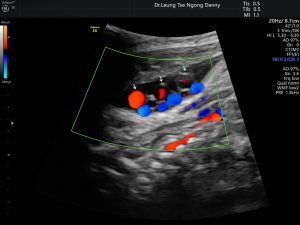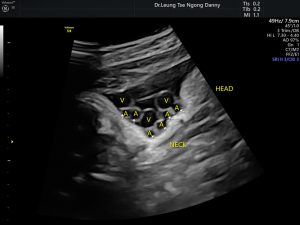1. How common is nuchal cord?
- Nuchal cord is defined as the umbilical cord has wrapped around the fetal neck for > 360 degrees;
- It is found in 15-35% of deliveries;
- In one study involving 237 fetuses between 13-16 weeks of gestation, cord entanglement at any part of the body can be found in 63% of fetuses on ultrasound, 27% were around the neck;
- In another study involving 84 fetuses with serial examination at 4 time points: 24 weeks, 30 weeks, 36 weeks and at delivery, 60% of fetuses had nuchal cord at one or more of the 4 study evaluations. The incidence rose progressively from 12% at 24 weeks to 37 % at delivery. Of all fetuses with a history of nuchal cord, 55% had it only once. Persistence of the nuchal cord from one time point to another occurred in 24% of fetuses only;
- Hence, nuchal cord is a common and transient event
2. Does nuchal cord increase the risk of intrauterine fetal demise?
- No, it does not. Of those pregnancies complicated by intrauterine fetal demise, the incidence of nuchal cord is not increased;
- The fetus does not have to breathe for oxygen in-utero. The lungs are filled with fluid and are not ready for gaseous exchange yet. The oxygen supply to the fetus is from the placenta via the umbilical cord;
- Even if the fetal neck is tied by a rope inside the uterus, the fetus will still have adequate oxygen supply as long as the umbilical cord is not compressed;
- The most important thing is to avoid cord compression
3. What about if the nuchal cord is tight?
- Nuchal cord is seldom very tight;
- If the nuchal cord is tight, the fetal movement might be reduced as the movement can lead to cord compression;
- If the fetus is active, it is unlikely that the cord is tight
4. Does nuchal cord pose any risk during labour and delivery?
- Nuchal cord, especially multiple loops may increase the risks of abnormal fetal heart tracing during labour and low fetal PH values at birth;
- It is associated with a higher chance of requiring vacuum extraction or forceps to speed up the delivery;
- It is not associated with higher chance of low neonatal apgar score at birth, admission to neonatal intensive care unit or birth asphyxia.
5. Is nuchal cord an indication for caesarean section?
- Nuchal cord, by itself is not an indication for caesarean section;
- Most fetuses with nuchal cord can achieve successful vaginal delivery with good perinatal outcome
6. How is the baby delivered if there is nuchal cord?
- The labour management is the same except continuous fetal heart monitoring during labour is a must;
- Upon the delivery of the fetal head, the umbilical cord can usually be hooked out by a finger and delivered first before the shoulders and the truck are delivered. If the umbilical cord is very tight, it can be clamped and severed first. The cord can then be unwound before the shoulders are delivered
7. Is it important to look for nuchal cord on routine antenatal ultrasound?
- It is not a straightforward ‘yes’ or ‘no’ answer;
- The active search for nuchal cord on routine antenatal ultrasound may induce some form of anxiety on the part of the pregnant women who can do nothing to unwind the cord. Also, it is mostly a transient event especially before term and it may disappear on the scan 4 weeks later;
- For those with no nuchal cord, it does not guarantee that nuchal cord will not occur in the next few weeks to come;
- The principle on the monitoring of fetal movement should be the same whether nuchal cord is found on ultrasound or not; medical attention should be sought if the fetus is inactive;
- In places where home delivery or intermittent fetal heart monitoring during labour is practiced, the identification of nuchal cord prior to labour is important because of its association with abnormal intrapartum fetal heart tracing. Home delivery and intermittent fetal heart monitoring are not advised if nuchal cord is found
Remember: for the great majority, the nuchal cord is like a neck scarf, not a noose!


